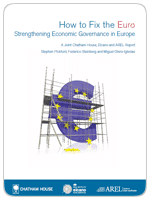Click ‘Download PDF’ to read the full Policy Paper.
Executive Summary

The euro was launched 15 years ago through the Maastricht Treaty, and was expected to make Europe stronger economically and more integrated. Although the Delors report in 1989 correctly identified many of the structures needed to make EMU work, the Maastricht design underplayed the importance of labour and product flexibility, and of divergences in competitiveness. For most of its first decade the euro area grew quickly, coinciding with a period of very rapid world growth.
However, the global economic and financial crisis that started in 2007 hit Europe hard, exposing serious flaws in its original design. Although the crisis began in the United States, Europe ended up being the worst-affected region. At one point, markets and commentators began to ask serious questions about whether the single currency could survive.
Important measures were taken to save the euro, and since 2012 markets have become calmer, as European leaders and policy-makers signalled they were prepared to take tough decisions. In particular, the president of the European Central Bank (ECB), Mario Draghi, promised to do ‘whatever it takes’ to protect the euro.
This report examines why the economic and monetary union (EMU) was so badly affected by the crisis, and assesses whether further changes need to be made to the structure of economic governance that underpins it.
Key findings
As the crisis unfolded, the problems facing the euro area were initially misdiagnosed. In the first phase, the crisis was thought to be largely a US, or Anglo-Saxon, problem; and the policy response was predominantly by individual member states, with limited coordination across Europe. In the second phase, as the situation in Greece became critical and as further sovereign debt issues emerged, the main problem was perceived by Europe to be fiscal profligacy in the ‘south’, and the primary response was to tighten fiscal policies. Not until the third phase, when countries faced much higher costs of borrowing and the full extent of the vicious circle between sovereign and banking debt problems became apparent, did the euro area finally start to tackle comprehensively its underlying financial-sector problems. It also came to understand that only the ECB had the necessary tools to deal with the crisis, and that these needed to be accompanied by commitments to further integration and structural reforms in the euro area.
Only in the more recent phases did the policy focus shift from crisis management to longer-term reforms. But the process of reform has been laboured and slow, with difficult political decisions often being taken only when the situation became critical. Its sequencing has also been complex, with the ECB making clear that measures to deal with the crisis were dependent on political agreement to further reforms to bring about greater integration in the euro area.
The crisis exposed serious shortcomings in the design of EMU. The euro area falls well short of the requirements for an optimal currency area. In particular, its members have not converged sufficiently; indeed, during the ‘Great Moderation’ divergences in competitiveness between euro area countries increased substantially. Also, euro area economies are not flexible enough. Furthermore, EMU does not have mechanisms to allow transfers from the stronger to the weaker economies. Nor does it place suffi- cient responsibility on surplus countries to make adjustments to deal with imbalances.
The experience of the euro shows that political considerations are also important. There needs to be deep fiscal integration within the currency area, a lender of last resort for sovereigns and banks, and an effective mechanism to break the link between banks and sovereigns (the ‘doom loop’). Euro area countries learnt the hard way that joining EMU meant that they were issuing debt in a currency that they did not control.
Without exchange rate flexibility or sufficient factor flexibility, the internal devaluation needed to adjust to falling competitiveness produced a deep recession and persistently high unemployment in countries with external deficits. The euro area experience also shows that countries joining the currency union have insufficient incentives to implement the structural reforms needed to make their economies more flexible and more convergent.
Much of the initial reform energy has been concentrated on strengthening fiscal discipline on euro area members; but countries still have incentives to circumvent the tighter rules, and little has been done to integrate fiscal policy more closely across the euro area. There is still a widespread view in Europe that the main problems lie with countries’ unwillingness or inability to implement the rules properly. But experience shows that strict adherence to the fiscal rules is not enough.
There have also been substantial reforms in the financial sector, but important obstacles remain. New policies have been put in place or proposed, and new institutions created at the European level, to strengthen financial regulation and supervision, resolve failing institutions, guarantee deposits and introduce macroprudential policies. But to complete these reforms, agreement is needed on a common fiscal backstop, and on how to divide the costs of resolving failing banks and protecting depositors; the many bodies responsible for different aspects of financial policy need to coordinate better; and a proper lender of last resort for the euro area is required. Structural reforms and macroeconomic coordination have also been started, but there is an underlying tension between national and European interests.
Structural reforms are essential to make EMU function more effectively, but most of the responsibility for designing and implementing these reforms lies with individual countries. Given the interconnections across the euro area, structural reforms should be better coordinated. The current lack of macroeconomic coordination between member states, and across the European institutions, also needs to be addressed.
Taken together, the governance reforms are moving in the right direction, but they do not go far enough to make EMU work effectively. Without deeper fiscal and economic integration, and the institutions to deliver it, the monetary union will remain unstable and vulnerable to further shocks. And to deliver this deeper integration, some degree of greater political union will be required.
In the absence of sufficient economic convergence, fiscal transfers are indispensable to offset asymmetric shocks. But there also needs to be a deeper fiscal union with strong and credible surveillance over countries’ budgets in order to avoid moral hazard, union-wide taxes to raise revenues, and centralized debt instruments to fund a common budget and ensure debt sustainability.
The monetary union also needs a sovereign lender of last resort, and a banking union with a common fiscal backstop to avoid financial fragmentation and break the link between banking and sovereign debt. The lack of an effective mechanism to break this link exacerbated the divergence in economic performance between the core and the periphery of the euro area.
So, within the euro area, fiscal policies have to be more coordinated, financial systems more integrated, and structural economic policies more convergent. Also, there needs to be more effective coordination between these policies, which are the responsibility of different institutions with varying powers and accountabilities. And this has to be backed up by adequate political institutions and governance structures capable of responding in times of crisis.
Political constraints
These reforms will not be easy. The experience to date is that European decision-makers find it very difficult to agree reforms unless faced with a crisis.
Moving towards fiscal, banking and economic union also entails a substantial transfer of sovereignty. This raises big questions about democratic legitimacy and accountability. There is a risk that decisions will be increasingly made at a level that most European citizens perceive as too remote. This can probably only be addressed by moving towards some form of greater political union involving enhanced powers for the Commission and European Parliament – and this poses yet greater obstacles, since it requires reforming the European Union treaties.
There are a number of important obstacles to changes which would tackle the democratic deficit. One difficulty is to manage Germany’s increased power on economic (and political) matters. Another obstacle is that a number of other countries are reluctant to open up treaty reform again. Finally, many euro area politicians feel that until growth resumes and unemployment falls, there is no significant popular support for more integration at the European level.
It is feasible to achieve deeper integration on an intergovernmental basis, but it would result in a loss of sovereignty for ‘debtor’ countries. For example, giving more powers to the president of the Eurogroup while retaining final decision-making at the Council level would, in principle, not need a substantial treaty change. But it would give a greater veto power to smaller creditor countries.
Ultimately, deeper integration that preserves symmetry requires transferring more powers to European institutions, and this can only be achieved through treaty change.
Recommendations: key governance reforms
- The experience of the crisis shows that, in order for EMU to function effectively, there needs to be greater fiscal, financial and economic integration within the euro area to match the degree of monetary integration.
- The euro area needs a single central fiscal authority with its own source of revenues, the ability to issue debt, and the capacity to make ongoing fiscal transfers within the euro area. This authority (headed by the president of the Eurogroup – in effect the economic and finance minister for the euro area) should also be responsible for monitoring national fiscal positions, and enforcing the fiscal rules. It would in addition set the overall fiscal stance for the euro area as a whole, and debt issued centrally would be joint liabilities of all euro area members.
- There needs to be a single financial rule book, and a common mechanisms for supervising all euro area banks (both big and small), resolving failing institutions and guaranteeing deposits. Some of these are currently being put in place. But there also needs to be further progress on putting in place a single resolution mechanism and a common deposit guarantee mechanism. Progress on these is being held up because of a failure to agree on how the costs would be divided.
- The single resolution mechanism needs to have a credible financing structure. With bank liabilities in the euro area totalling over €30 trillion and given the possibility of large bank failures, both the resolution mechanism and the common deposit guarantee system need to have a clear fiscal backstop, ultimately provided by the central fiscal authority.
- Positive incentives need to be put in place for countries to undertake difficult structural reforms on an ongoing basis, so that their economies are flexible and innovative enough to live within a single monetary area. The single fiscal authority could provide finance for country-specific reforms that are essential for the area as a whole. Contracts between countries and European institutions to provide financial resources for structural reforms could provide the right incentives.
- There need to be effective processes to coordinate monetary, fiscal, financial and structural policies – and the institutions responsible for them – across the euro area:
- a regular dialogue between the central fiscal authority and the ECB;
- close coordination between the ECB and the ESRB (as well as the central fiscal authority) on macro-prudential policies; and
- coordination by the Eurogroup of overall economic policies (both national and euro-areawide), backed up by regular economic summits of euro area leaders.
- The ECB needs to be able to act as the unconditional lender of last resort for member states in exceptional circumstances, as well as for euro area banks.
- These reforms will require new institutions, and changes to the mandates of existing institutions. Reaching agreement on the creation of a central fiscal authority and changes to the ECB’s mandate will be particularly challenging.
- The centralization of powers and resources that this greater level of integration involves will require a greater degree of political union, to provide democratic legitimacy and accountability. These proposals imply a profound transfer of sovereignty from member states to European institutions, and go beyond what has been proposed so far.
- Treaty change is ultimately the only realistic path to greater legitimacy and a more symmetric union. However, the last ratification process has left many countries reluctant to go down this path.
These changes are needed to make EMU work effectively, to realize its potential and to avoid future crises which could threaten its existence. But stronger integration and deeper union between the EA members will stand in stark contrast to the much more limited degree of coordination within the wider EU. This will provide nonmembers with a very difficult choice.
Some changes need to be made quickly in order to make EMU more resilient. Others will take more time, given the political constraints. But until they are implemented, the economic and monetary union will remain vulnerable to further crises that could threaten the stability of the euro.
By the end of this decade banking union should be largely complete. The single supervisory mechanism should be fully operational and the single resolution mechanism framework in place, with a sizeable resolution fund financed through banking-sector levies (although it will still need a substantial fiscal backstop).
Some further integration can proceed on an intergovernmental basis, such as extending the powers of the Eurogroup president. But this is a second-best way forward, and may not be politically sustainable.
To achieve the more radical – but necessary – reforms, a new treaty will be required. A major priority for this new treaty would be to create a single fiscal authority for the euro area and to change the ECB’s mandate, so that it could become a full lender of last resort in extreme circumstances.
Finally, euro area citizens need to be given a real choice between continued fragmentation (which leaves the euro exposed to structural weaknesses and recurrent crises), and greater integration (which pools more sovereignty at the same time as it strengthens the governance of EMU).
Stephen Pickford
Senior Research Fellow at Chatham House.
Federico Steinberg
Senior Analyst at the Elcano Royal Institute and Professor of Political Economy at Madrid’s Universidad Autónoma.
Miguel Otero-Iglesias
Senior Analyst at the Elcano Royal Institute and Research Fellow at the Centre for European Integration at ESSCA School of Management, Paris.






